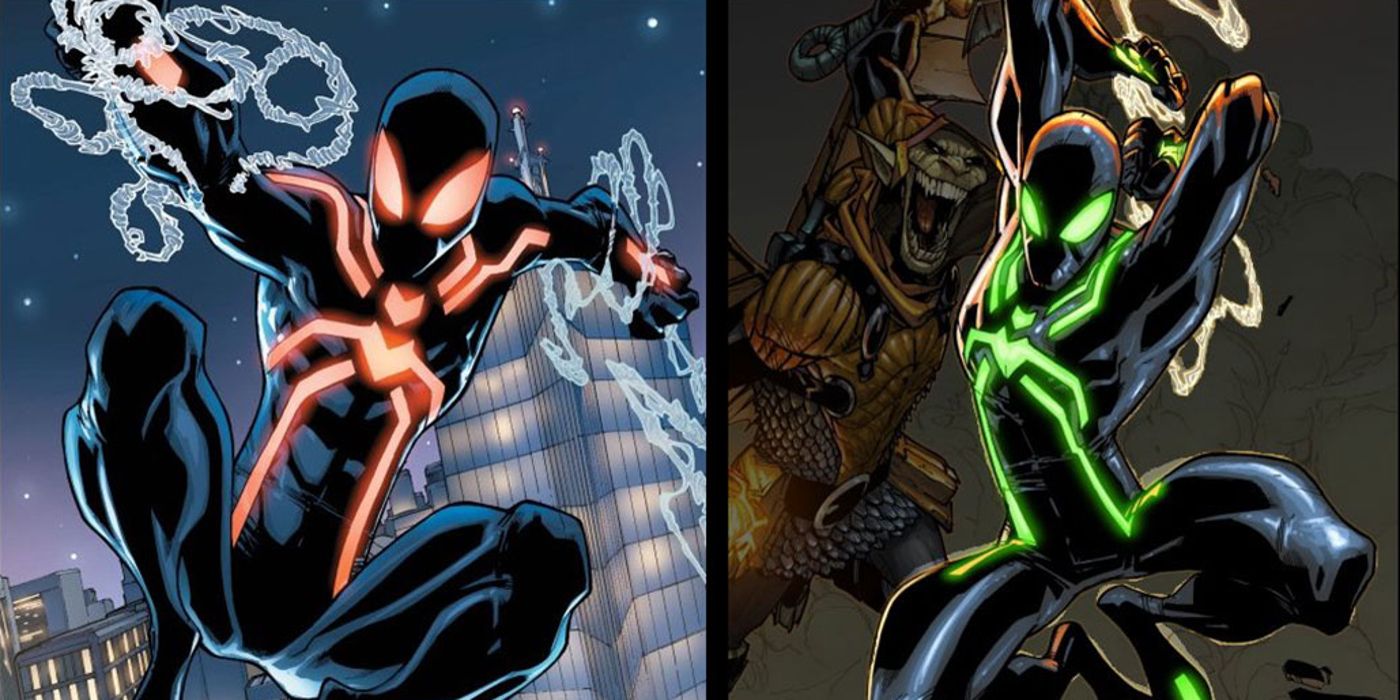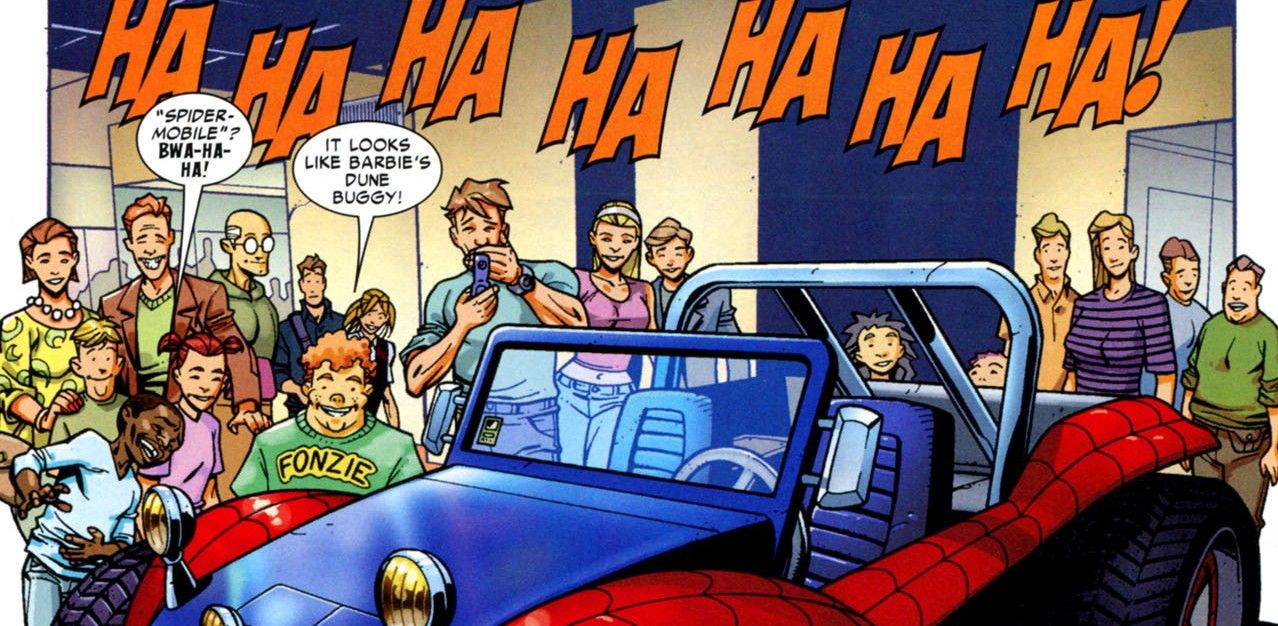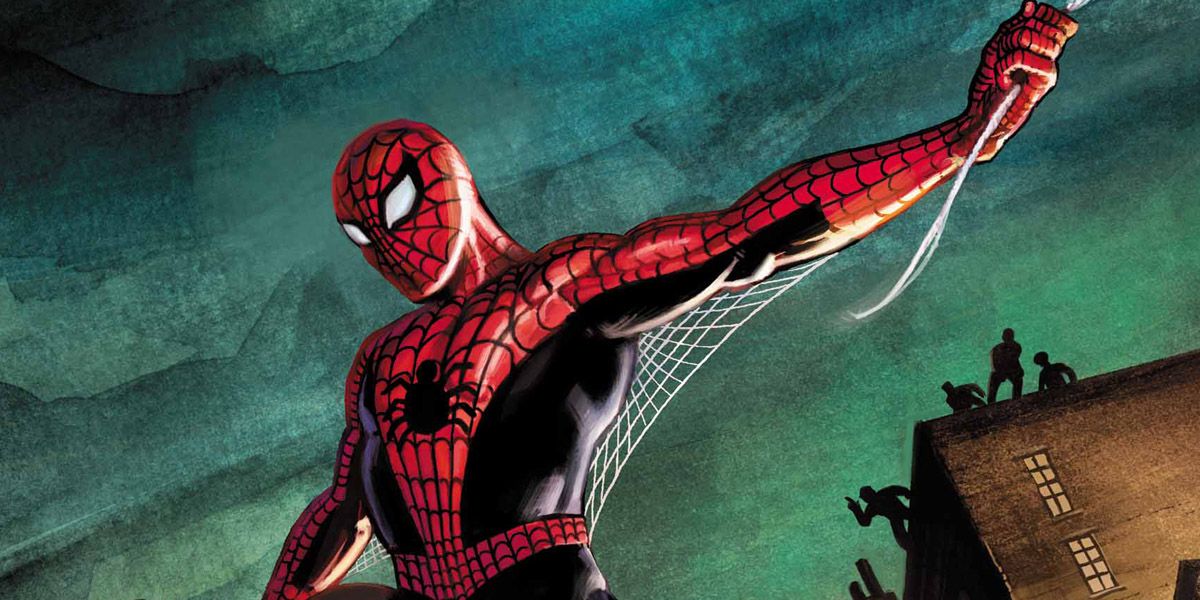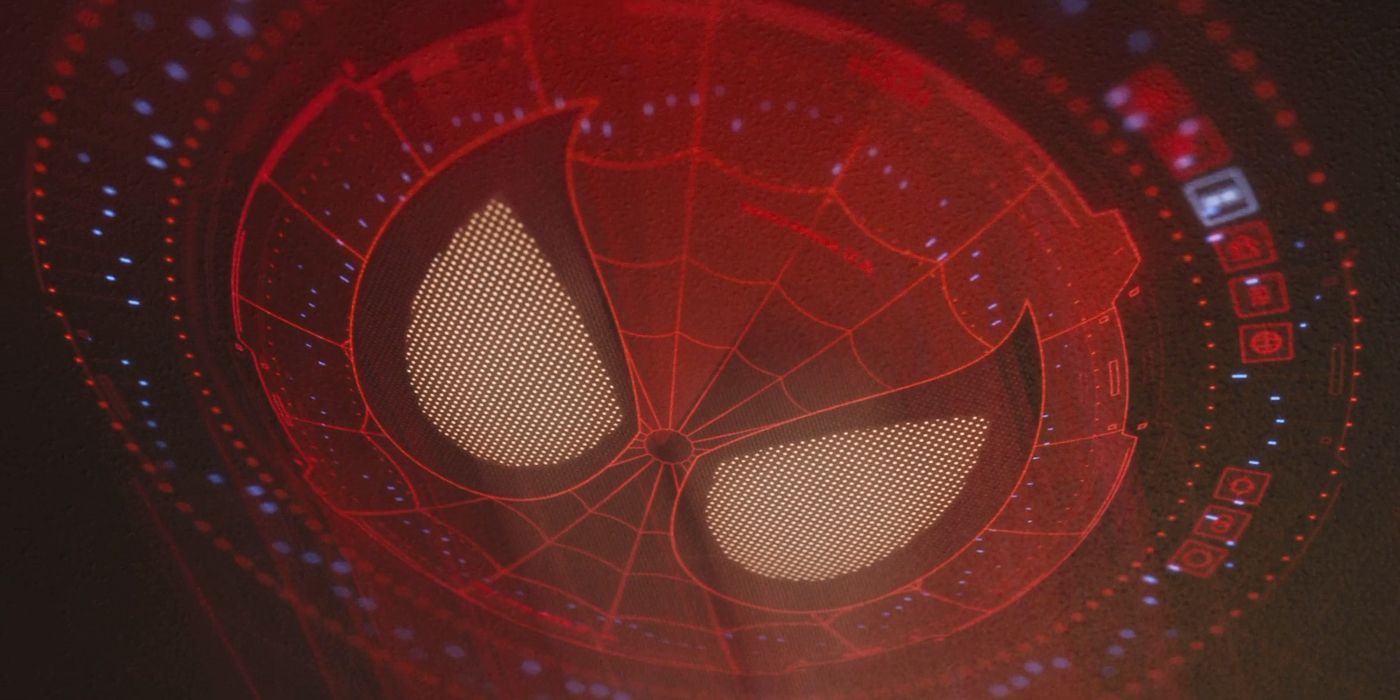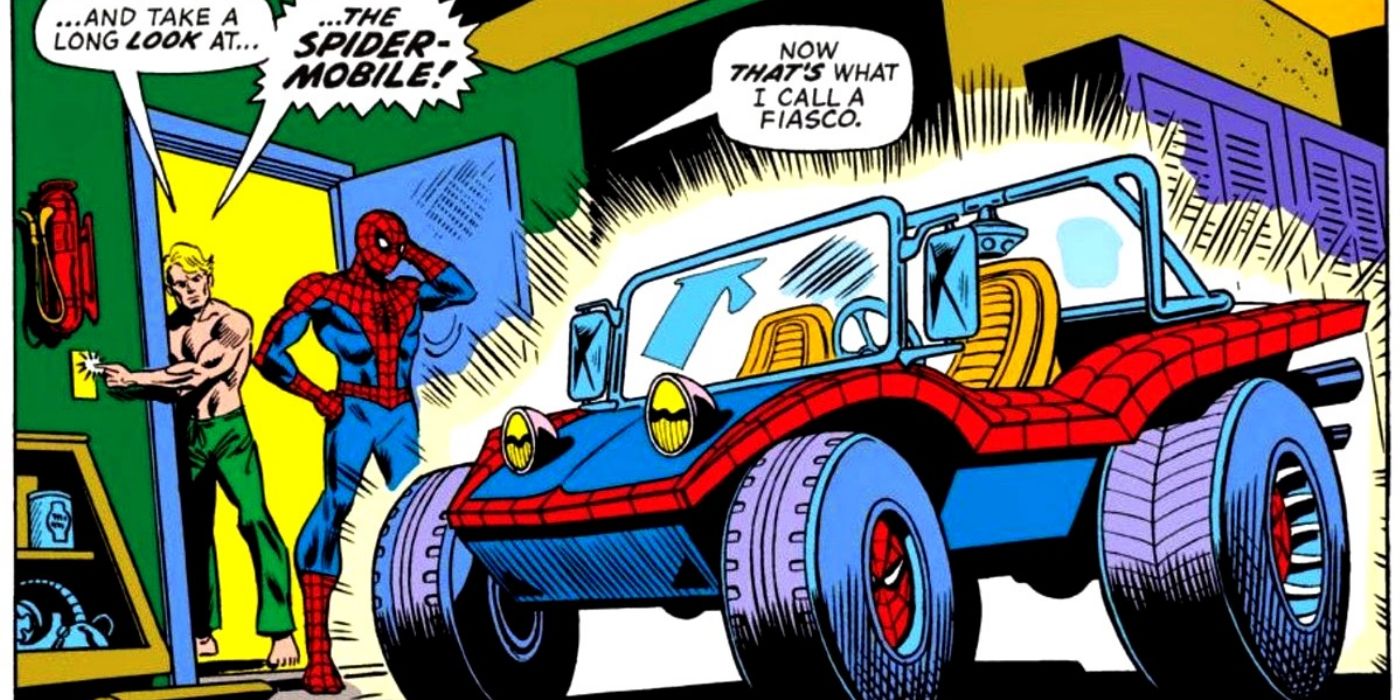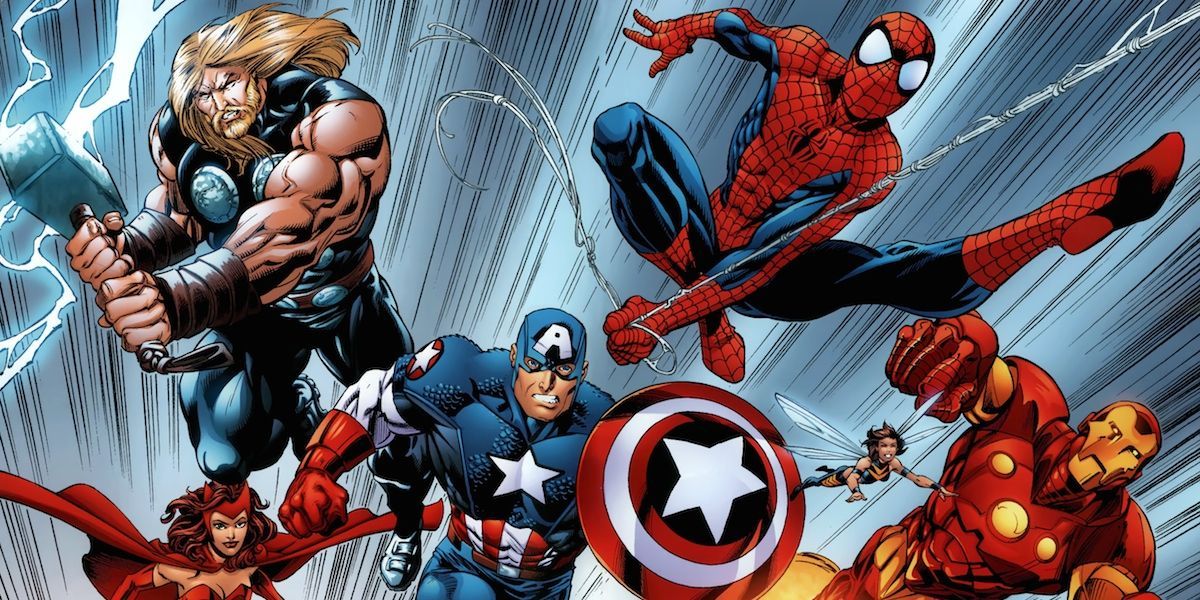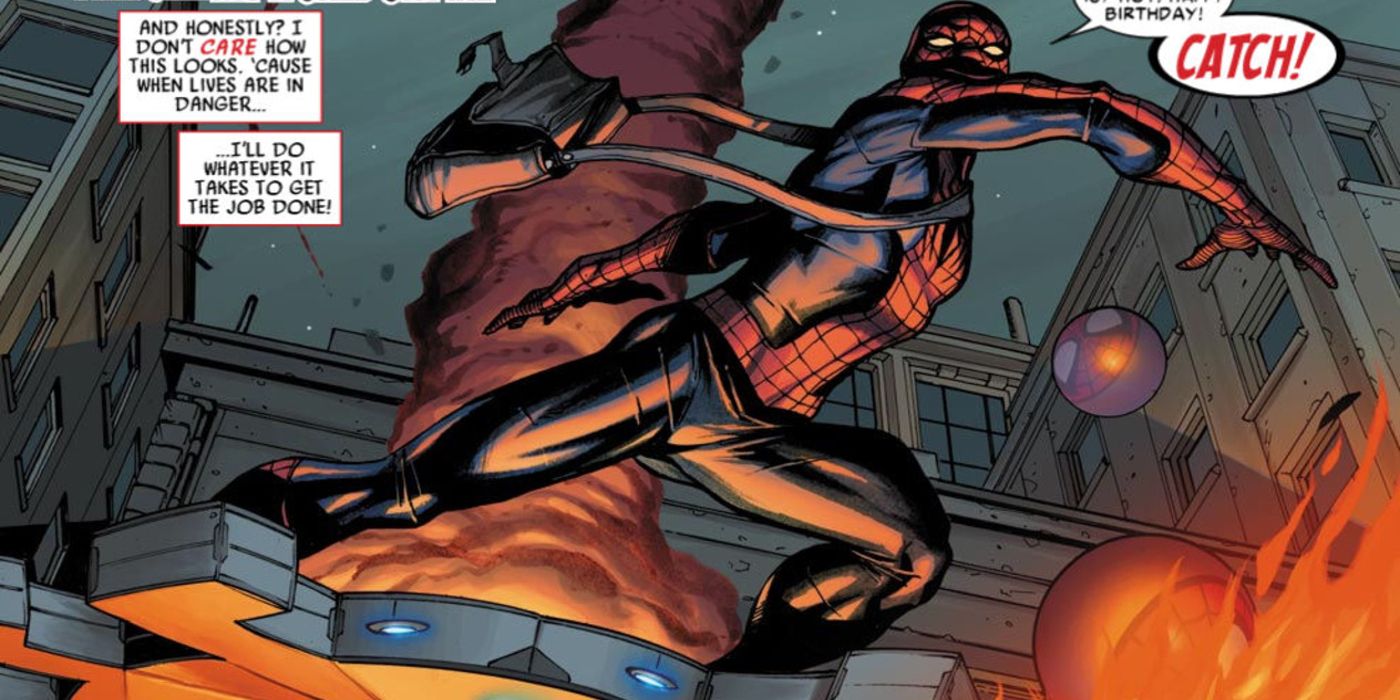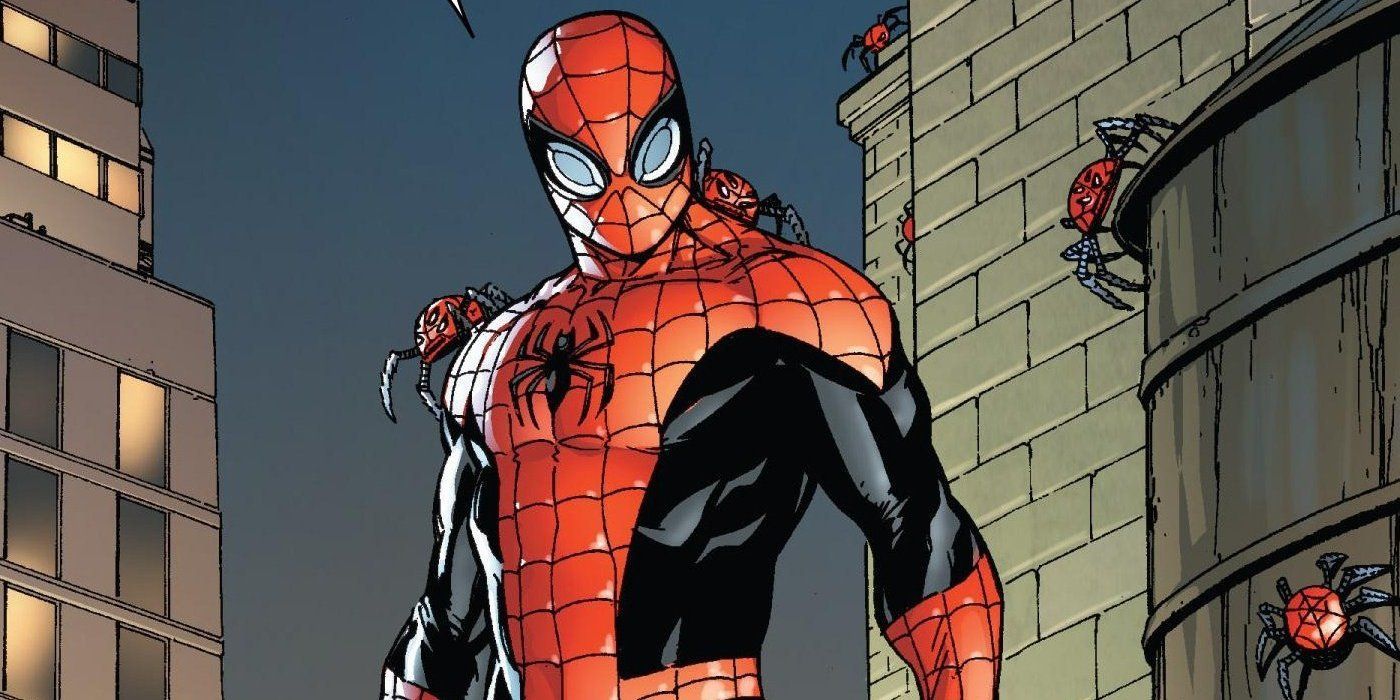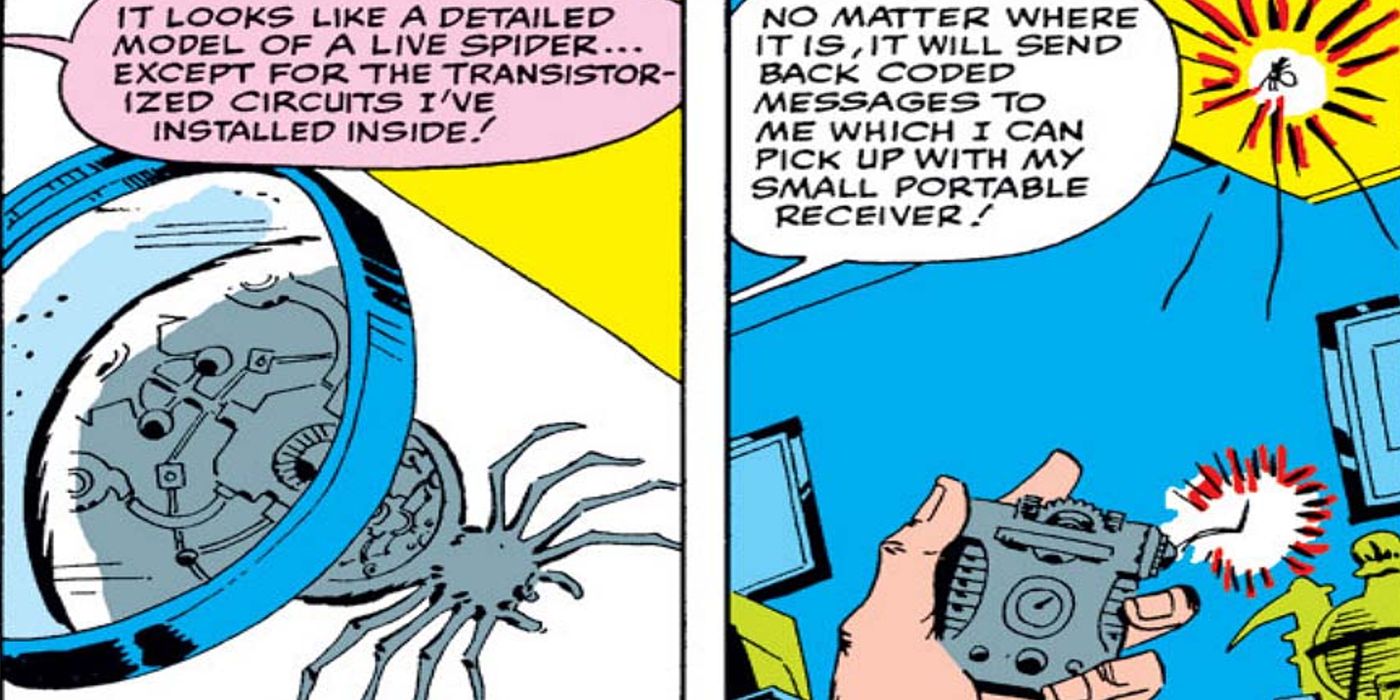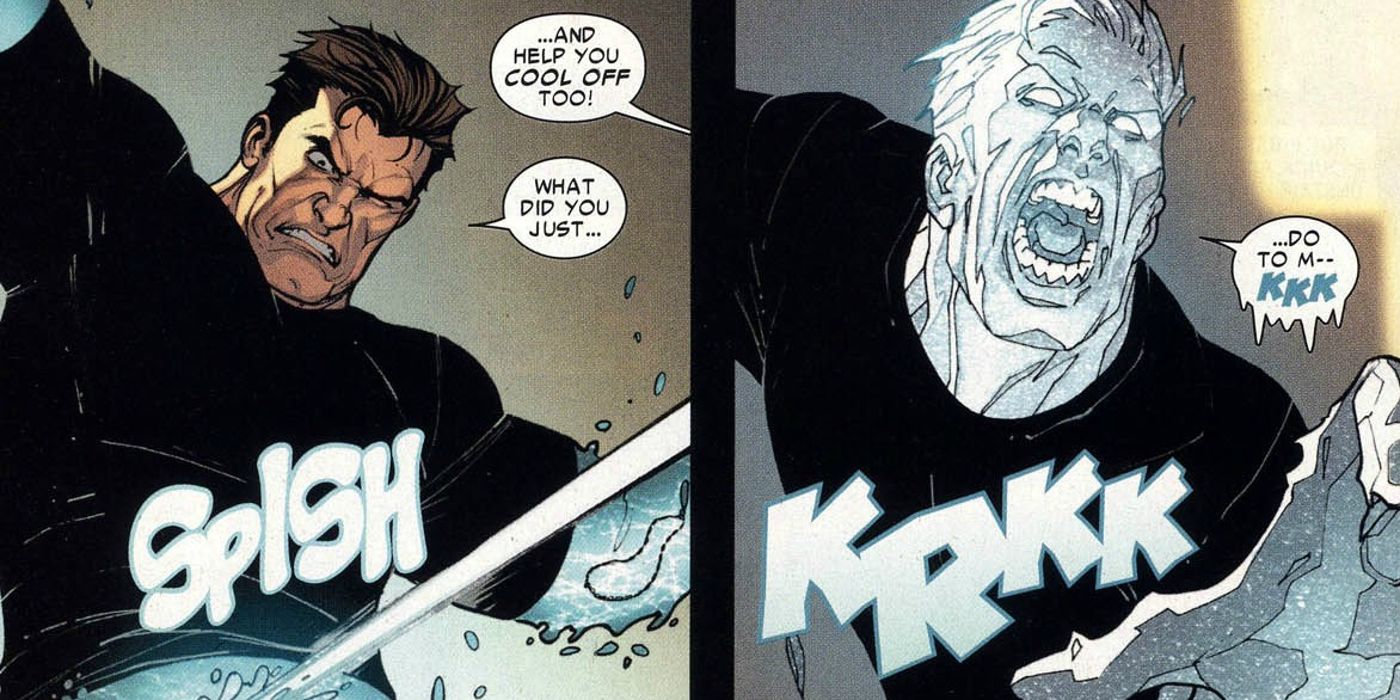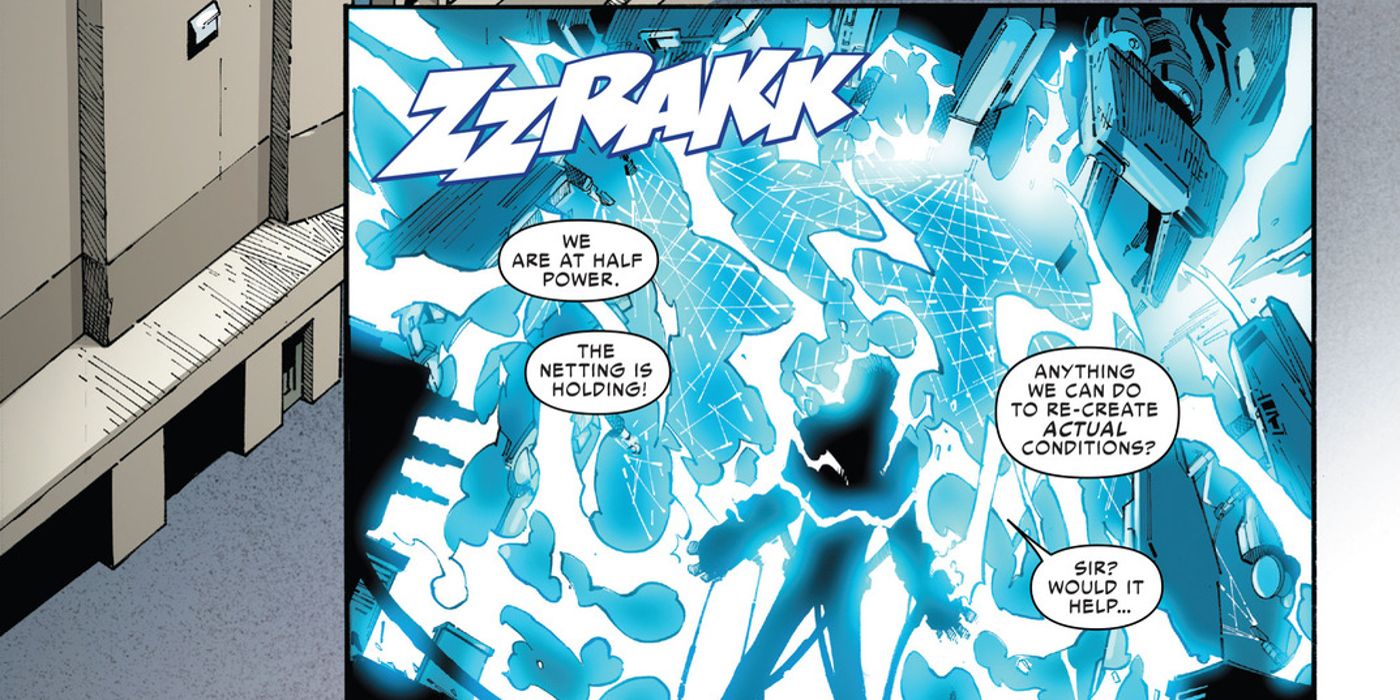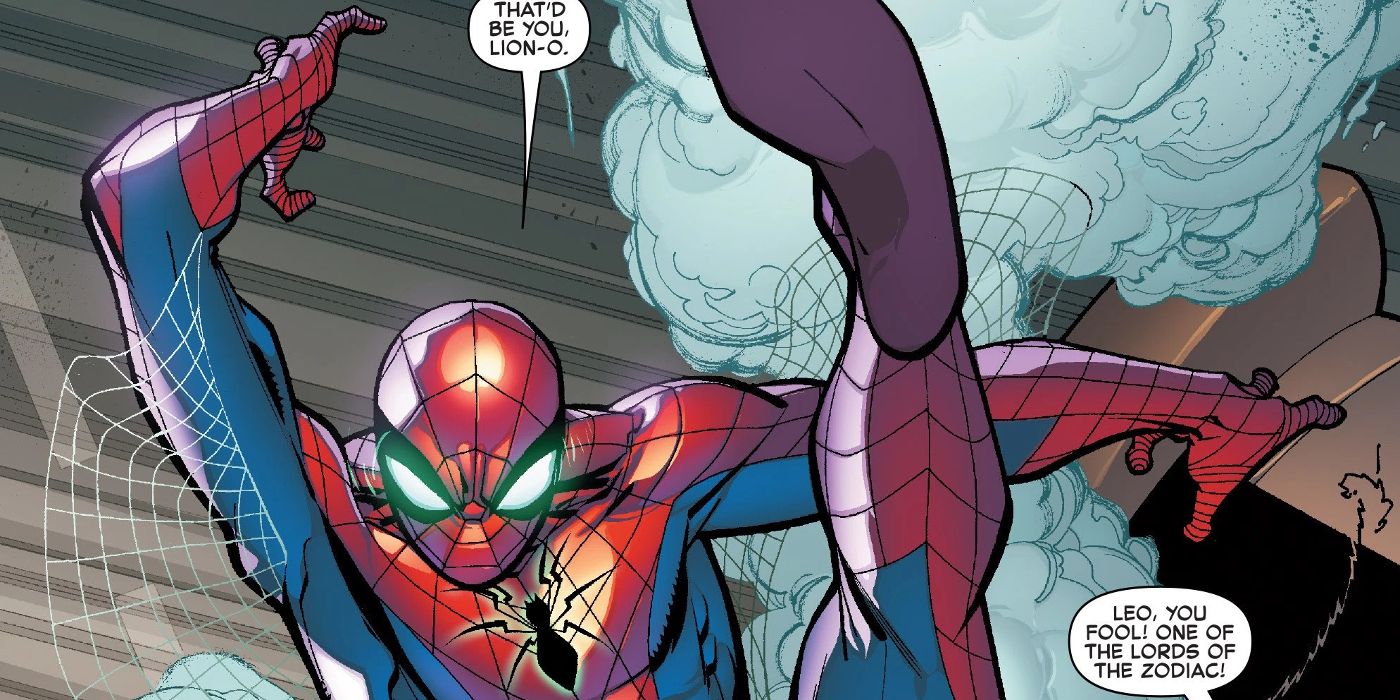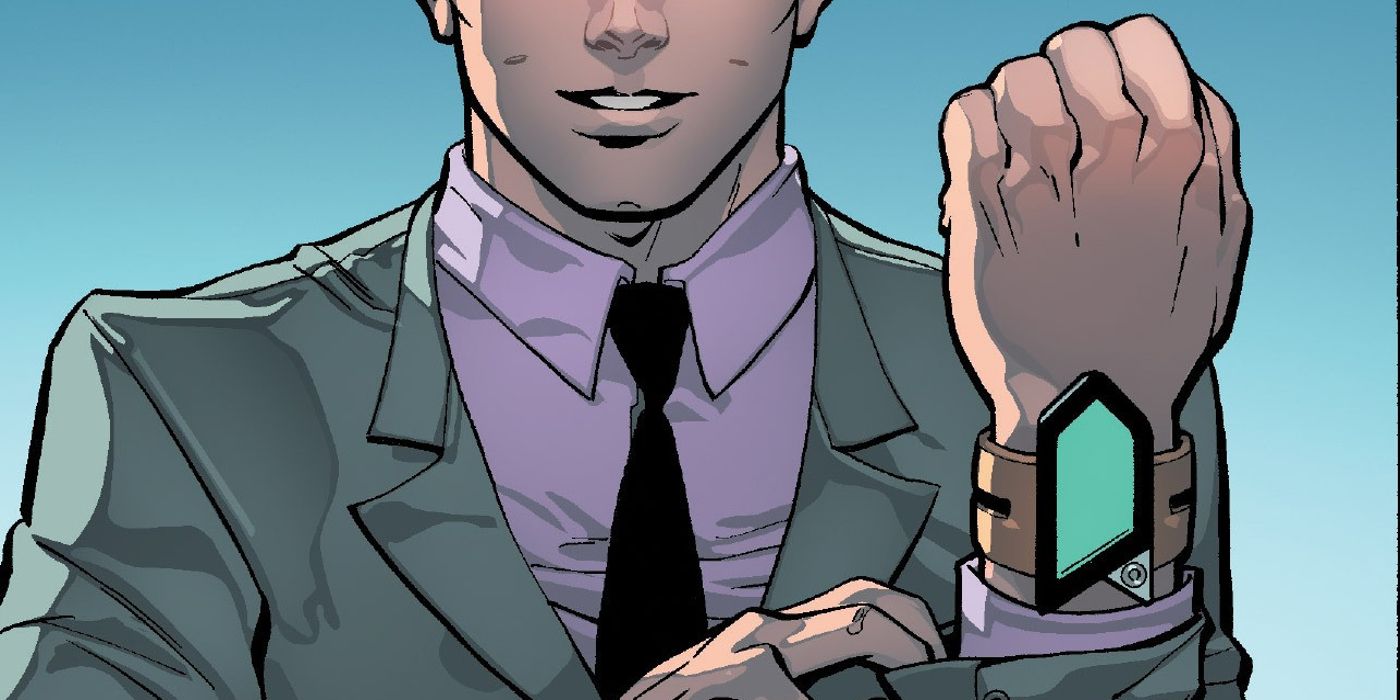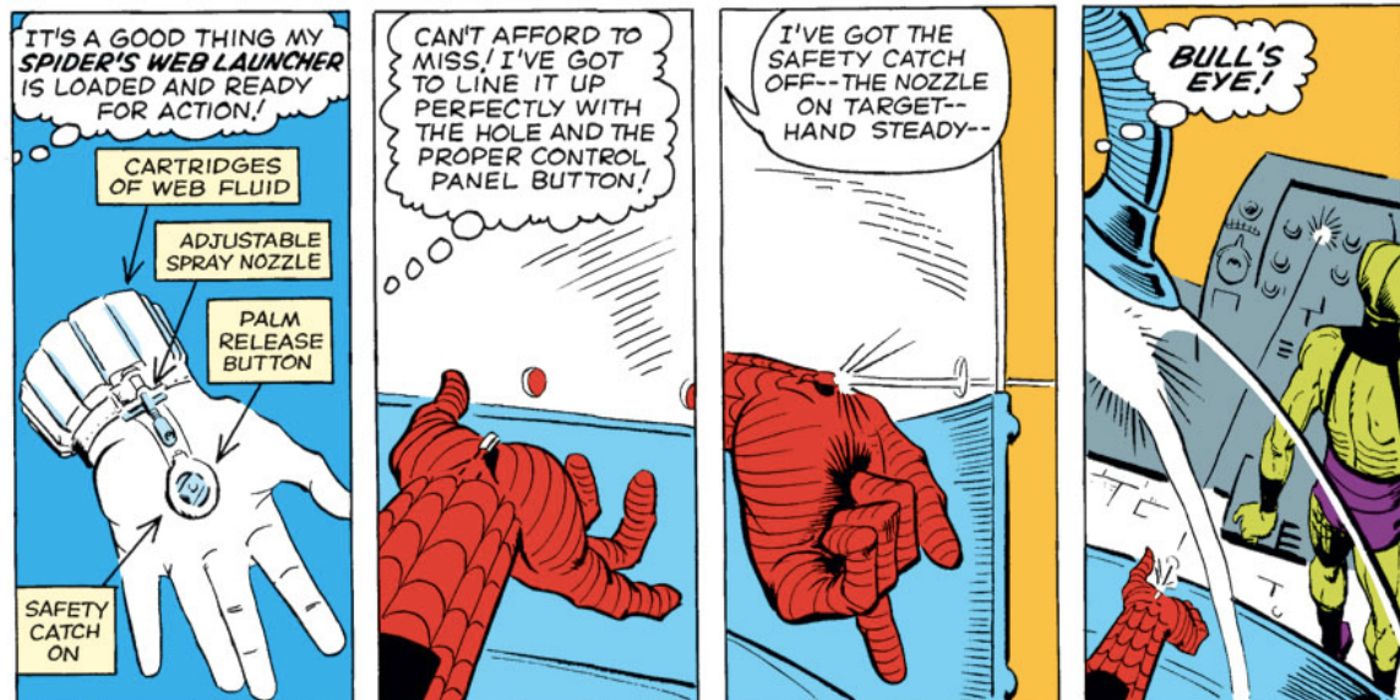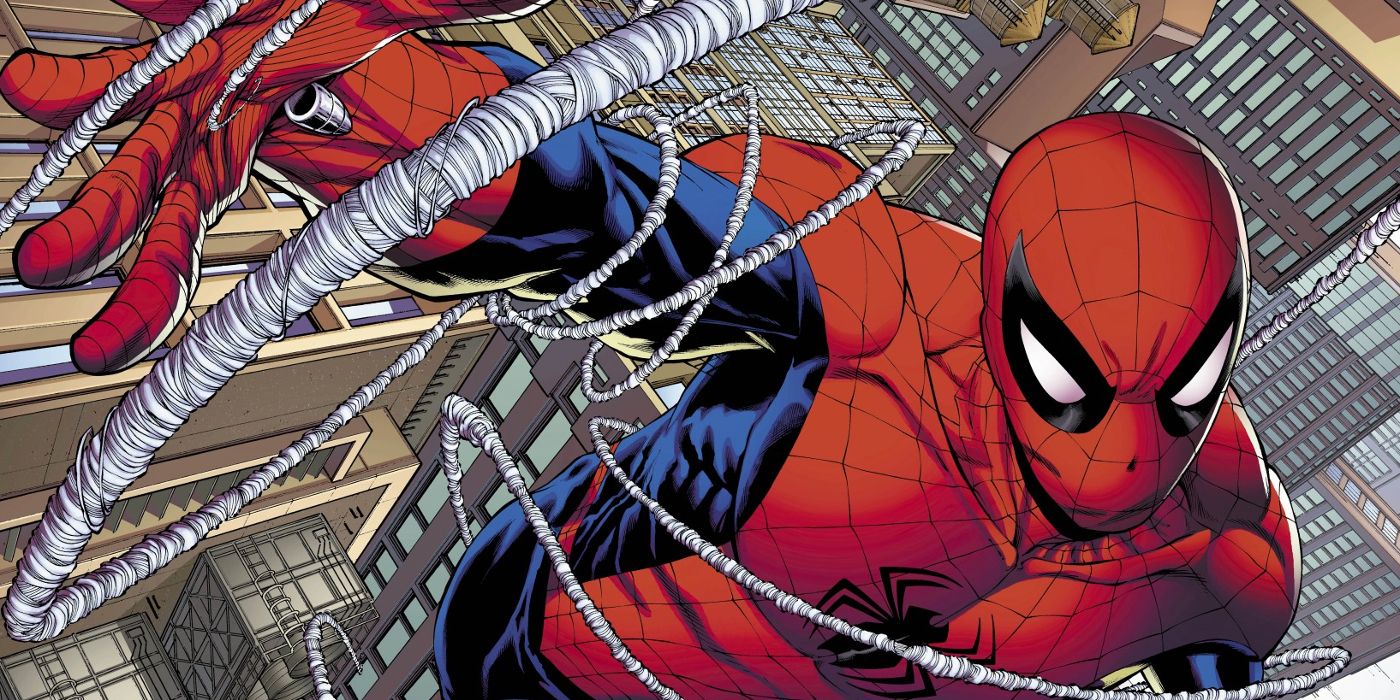Spider-Man may have super-strength and a suite of other superpowers, including his iconic Spidey-sense, but the one thing that sets him apart from many other heroes is his incredible intellect. His IQ is stated to be above 250, making him one of the smartest people on the planet. As Spider-Man, Peter Parker's intelligence and ingenuity often help him in battle when brute force isn't an option. But some of his inventions have even improved the daily lives of average people in the Marvel universe.
Over the years, Peter has used his keen scientific mind to invent a bunch of different gizmos and accessories to help with his heroic web-slinging career as Spider-Man. He's also received some pretty awesome toys and tech from his equally brilliant superhero counterparts that we couldn't help but include on this list.
From costumes and vehicles to weapons and tools, here are Spider-Man's 15 Best Gadgets And Inventions.
15. His classic costume
Few superhero costumes are as iconic and instantly recognizable as Spider-Man's classic red and blue suit. In the original comic, Peter's first costume was a wrestling outfit, consisting of a white turtleneck and blue pants with some netting over his face to act like a mask. To put it charitably, it's not his best look, but it does manage to keep his identity hidden. When he's asked to appear on television, Parker decides he needs an upgrade and sets about sewing and making a far better (and much less stupid) outfit.
The proper spider-suit is skintight and allows for the freedom of movement that our acrobatic hero needs to swing and flip across the city. It also allows for his signature wall crawling without hindering his grip. The mask's eye pieces are white one-way mirror lenses, hiding Peter's eyes without sacrificing his vision. Nearly all of Steve Ditko's original design is still used today. The only notable difference is the lack of underarm webbing, a change that was brought about when John Romita Sr. took over art duties on the comics in 1966, but it still returns occasionally depending on the artist and/or suit.
14. Utility belt and Spider-Signal
Every good superhero never leaves home without a trusty utility belt and Spider-Man is no exception. The belt's main purpose is to hold extra cartridges of Spidey's necessary web fluid. Without it, his mobility and combat effectiveness are compromised, so bringing spares is crucial. The belt has also housed his all-important camera, enabling him to snap pictures of himself in action for an ungrateful and probably angry J. Jonah Jameson.
The other main function of the utility belt is to house the Spider-Signal. Unlike the call-to-action Bat-Signal, the Spider-Signal is a light contained in Spidey's belt that projects an image of Spider-Man's mask. It's mostly used to announce his arrival or intimidate criminals, but it can be used as a flashlight when Peter finds himself having to navigate dark areas like the sewers. In Amazing Spider-Man #675, Peter updates the Spider-Signal with a UV light to scan crime scenes for forensic evidence. Despite five solo movies, the Spider-Signal hadn't made a big-screen appearance until the post-credits scene for Captain America: Civil War, which showed Peter discovering it in the web-shooters Stark had made for him.
13. The Spider-Mobile
Spider-Man's main form of transportation is web-swinging, so why on Earth-616 would he need a car? Reports about the reason for the car's sudden (and brief) inclusion in the comics vary, but one way or another, it was created to sell toys. In the comic, Spidey is approached by two advertising execs named Carter and Lombardo. They offer him a deal to drive a car with a Corona Motors engine. Peter initially refuses, but grudgingly accepts when he can't pay rent and is being threatened with eviction. Peter and Johnny Storm build a car from scratch to house the engine. It's basically a buggy decked out in red and blue, complete with a Spider-Signal and web-shooting ability. Spidey used it for a while before being tricked by Mysterio into driving it into the Hudson River.
The Spider-Mobile's sheer pointlessness has made it a laughingstock for years; it's often brought up in “worst idea ever” comic book discussions. Amazing Spider-Man #600 showed the car on display at the Smithsonian, surrounded by a mocking crowd. However, there's arguably some merit to the idea, especially since the concept has been modernized. As CEO of Parker Industries, Peter designed and commissioned a newer, cooler, sportier version of the Spider-Mobile. The new model can drive on walls and upside down, and has a high-tech computer system, web-fluid airbags, and spider-like mechanical legs that fold out to skitter around Shanghai. While Spidey hardly needs it, a supercar that can drive on the side of a skyscraper is undeniably cool.
12. Avengers Identicard
While the actual card was invented by Tony Stark, it still serves as one of Spider-Man's more useful gadgets. As a member of The Avengers, Peter gets an Identicard. It looks similar to a standard Photo-ID driving license, but it's actually a powerful microcomputer, capable of complex tasks. It's mainly used as a communicator, with a screen built in to send and receive audio and video. The card also grants top level security access in countries across the globe and helps Avengers identify other friendly heroes who may be members of various splinter groups, like the West Coast Avengers.
Each Identicard has a locator that works globally via satellite and emits a unique signal for each hero, meaning that any hero can be tracked and located quickly if in need of assistance. It has a link-up with the Avengers' computers, meaning that heroes can access and use Avengers HQ's vast databanks from wherever they are. On top of all that, it also acts as an ignition key for any of the Avengers vehicles and as a keycard for the various Avengers bases. Handy.
11. The Stealth / Big Time suit
The red and blue suit, despite being a classic, isn't exactly subtle. When Peter worked at Horizon Labs, he needed to create a suit that countered sonic attacks like the Hobgoblin's screams. Parker combined the work he'd done with Hank Pym and Tony Stark to create the ultimate crime-fighting outfit. He reworked the costume using “omni-harmonic mesh” to bend light and sound around the suit and use unstable particles. The result is a suit that can make Peter practically invisible. The costume itself is black, with a large neon spider logo that stretches across the body and matching glowing eye pieces. Aside from looking cool, the color of the lights indicate which mode the suit is in.
Green indicates camo mode, meaning Spidey's basically invisible to everything but a few special lenses and frequencies. If the suit glows red/orange, it's in Anti-Sound mode, a noise-cancelling function that protects Peter from sonic attacks. In terms of new weapons, Parker equipped it with “Anti-Metal Spiders”- spider-shaped devices that can be fired from the wrist and dissolve metal objects. If that wasn't enough of an advantage, the suit can also repair any damage sustained if the wearer merely wills it. The stealth suit wasn't given a proper name in the comics, so fans have taken to calling it the "Big Time" suit after the story arc it appeared in.
10. Parker Particles
Peter may be smart enough to hang with Marvel geniuses like Reed Richards and Hank Pym but it's clear that he doesn't always have the wisdom to match his intelligence. Peter discovers a a form of hyper-kinetic energy which is “tied into the forces of universal expansion itself”. This basically means that Peter had just unearthed a form of clean, near-limitless power with endless applications. And he called them Parker Particles.
However, what Peter doesn't know is that Reed Richards had discovered them years before and kept his research secret, deeming them too dangerous to announce. Parker holds a Horizon Labs demonstration of his “new” "discovery" and it all goes wrong thanks to the safety protocols being sabotaged. The accident gives average-nobody student Andrew Maguire (a shout out to two live-action Spideys) a host of superpowers and turns him into the hugely powerful being Alpha. He's estimated by Reed Richards to potentially be a bigger threat than Sentry or The Incredible Hulk if not depowered. Peter eventually manages to limit Alpha's powers, but not without some collateral damage along the way. Not wanting a repeat situation, Parker shelved any more research and usage of the Parker Particles indefinitely.
9. The Spider-Glider
In Amazing Spider-Man #682 as part of the Ends of the Earth arc, Peter faced an unusual challenge in the form of Equinox, a thermodynamically charged villain with the combined powers of Iceman and the Human Torch-- he was able to create fire and ice simultaneously. Peter rose to the task by taking a page out of the Green Goblin's book and fashioning himself a glider of his own. The Spider-Gilder is a jet powered spider-shaped platform that enables Peter to fly high above enemies and negates many of Equinox's attacks.
Spidey took the Goblin thing a step further and carried a satchel full of custom-made Spider Bombs. The bombs were filled with thermo-reactive foam, capable of dealing with either temperature extreme and are able to finally defeat Equinox. Since the story, the Spider-Glider has been largely forgotten about, although it did make an appearance in the Disney Infinity video game.
8. Spider-Bots
In the divisive Superior Spider-Man arc, Peter Parker and Otto Octavius, AKA Doctor Octopus, switched consciousnesses, leaving Ock with full control of Peter's body and leaving Peter in Octavius' dying form. Ock set about making Parker's life his own, before slowly realizing Peter's struggles and stresses. After literally walking in Parker's shoes, Octavius eventually turns to the side of good and endeavors to be as heroic as he can be, but his actions end up being more misguided and morally questionable than anything else.
Octavius invents some Spider-Bots to assist him in his "heroics". The Spider-Bots are small, red-and-blue robots controlled via the mind (mental command is kinda Ock's thing). The bots are capable of scaling most surfaces and are mostly used as Ock Spidey's eyes and ears, recording video which can be accessed on numerous devices. The Spider-Bots are later equipped with face-scanning technology to help Ock identify crooks and targets. Most impressively, the bots can also be used to create strong forcefields when working in unison.
7. Spider-Tracers
The Spider-Tracers were one of Peter's first inventions and they share the same effective simplicity as Peter's other early gadgets. The small, electronic devices can be thrown onto an escaping vehicle or villain so that Spidey can track them across the city and be led to their secret hideout. Peter uses an electronic receiver to track the tracers, but can use his Spider-Sense to pinpoint one within a close enough radius. They were originally made to look like actual spiders, but in later issues, Peter would turn them into smaller devices shaped like the spider logo on his back.
However, the tracers were often found and either destroyed or used to bait a trap for Spider-Man. As the issues went on and technology improved, Parker would tinker with the original design and add new features. The updated Spider-Tracers were installed with a listening device, a GPS signal, and some much-needed camouflage. There have even been instances where Parker has weaponized them, with a modified “ice spider” tracer being used to freeze Hydro-Man.
6. Cryo Cubes
Peter built on his cryo-tracer technology whilst at Horizon Labs and invented the Cryo Cubes, which are capable of rapidly freezing living creatures and tissues without damaging them. Peter refines the formula and cryo cartridges soon became a permanent addition to his utility belt. Apart from freezing villains in place, the technology also has medical applications.
In one story, Peter saves people from a burning building (torched by our good friend Equinox) and comes across an unfortunate firefighter who lost his foot thanks to Equinox's ice powers. Spider-Man clears the way for medics to get to the man and rush him to hospital. Later, he swings by the hospital to check in with the firefighter. He learns that the man's foot can be reattached thanks to the intact foot being brought to hospital using a Cryo cube, meaning that he saved the man as Peter Parker, not as Spider-Man for once.
5. Anti-Electro Netting
After Peter got control of his body back from Doc Ock, he found himself adapting to the new life Octavius had shaped in his absence. One of the biggest changes was when Peter woke up to find he was a wealthy CEO of his own company.
After founding Parker Industries, Octavius had mind-controlled Electro, Sandman, and others into fighting for good and being his own version of the Avengers. Following these events, Electro had lost his street cred as a villain and set about proving he was still a big bad by storming the Raft, a prison that houses supervillains, and causing a mass breakout. Feeling responsible for Electro's actions, Peter set about bringing him in.
Parker and his team managed to invent Anti-Electro Netting. Working like a Faraday cage, the netting was able to trap and hold Electro, displacing the huge voltages he gave off before finally depowering him completely. The Anti-Electro Netting showed the gulf between Ock and Spidey's approaches to heroism and reinforced the fact that readers were once again in the company of good ol' Peter Parker.
4. Spider-Armor MK IV
Using the resources available to him via Parker Industries, Peter updated his costume as part of Marvel's All New All Different relaunch. While he kept the classic red and blue, the suit is now made of a liquid metal that responds to his mental commands. It's capable of holographic projection, meaning that it can simulate any form of clothing the wearer wants. The liquid metal means that the suit is much more durable than its cloth counterpart, and is able to withstand impact damage as well as being heat and bulletproof. Peter took lessons from the earlier Big Time suit and also made it resistant to sonic attacks.
The suit has built-in web shooters capable of firing different kinds of webbing as well as Parker's new and improved micro Spider-Tracers. It also comes equipped with “bug zappers”, small Taser-like projectiles capable of stunning targets. Peter adopted the MK IV as his standard costume in 2015, because it doesn't take a genius to see how a bulletproof high-tech supersuit is an upgrade from stretchy fabric.
3. Webware
Parker Industries has had many successful products, but its biggest commercial success and the product that put the company on the tech map is Webware. Webware is a wearable wrist device that allows people to get internet reception and unlimited data all over the globe. We don't need to tell you why this is a great invention, right? Webware and products like it led to Parker Industries to eventually being worth a cool $2 billion.
The Webware itself is based around Peter's old Spider-Tracer tech and incorporates the same basic GPS usage. Peter's Spider-Armor uses built-in modified Webware functionality to power some of its different facilities, including putting on and taking off the armor, as well as being the new home for the Spider-Tracers' signals. The tech is designed to be nearly impossible to hack due to its advanced encryption that is constantly being reconfigured by nanotechnology. Talk about safety first.
2. Mechanical Webshooters
Inventing web fluid wasn't enough on its own as Peter needed a device to fire it. Enter the mechanical webshooters, wrist-mounted devices capable of firing a tensile line of web sturdy enough for swinging. With practice and experimentation, Peter finds he can make all sorts of webbing by adjusting the pressure applied. The shooters not only shoot out rope-like web, but can also fire a spray capable of stopping crooks and ensnaring them in a sticky web. It can fire projectiles in the form of web-balls and also has a rapid fire web-barrage mode. They've been modified to be voice-activated too, so Spidey can yell out what kind of web he wants.
The web-shooters were part of Spider-Man's original design and were used to demonstrate Peter's intelligence. The Sam Raimi Spider-Man movies opted to give Peter organic webbing and the comics soon followed suit, but the status quo was eventually restored. It's interesting to note that when Otto Octavius took over Peter's life and started improving his various Spider-accessories, he didn't touch the web-shooters. Perhaps he admired their elegant design. Or maybe he couldn't figure out a way to put extra arms on one. We'll never know.
1. Web fluid
Webbing may not seem like Peter's most impressive invention, but it's certainly the most enduring part of Spider-Man's arsenal. Not only does it grant him the ability to swing and swoop through city skylines in his trademark way, but it's so multi-functional it'd put a Swiss Army knife to shame.
Peter has tweaked the original formula many times over the years. Depending on the situation, he's mixed the standard formula and created new blends such as acid, ice, cement, foam, and lead versions. He's also created special magnetic and electrified variations. If we're looking at the best Spider-Man invention, then it probably has to sum up its inventor to some degree and be something that only he could create. With that in mind, the webbing comes out on top. Not only does it showcase Peter's brilliant scientific mind and its ability to adapt to different scenarios, it's crucially a non-lethal weapon, choosing to catch, disarm, repair, and restrain rather than do any damage. The webbing neatly encapsulates what Spider-Man is all while simultaneously enabling him to do whatever a spider can.

